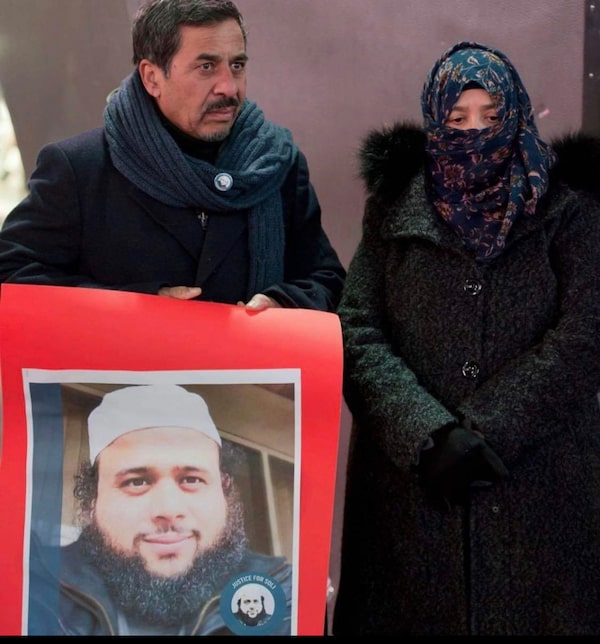
Soleiman Faqiri's parents, Ghulam and Maryam.Courtesy of Yusuf Faqiri
At the conclusion of a three-week inquest, lawyers representing the Ontario coroner’s office urged a jury to declare the 2016 jailhouse death of Soleiman Faqiri a homicide, and made a series of proposals that, if implemented, would overhaul the way Ontario jails operate.
Mr. Faqiri died at the Central East Correctional Centre after spending 11 days in severe psychotic crisis. On the afternoon of Dec. 15, a group of correctional officers forced him into a segregation cell, sprayed him twice with pepper spray, shackled him about the wrists and ankles, placed a spit hood over his head and left him stomach down on his cell floor.
He stopped breathing and was declared dead minutes later.
Subsequent investigations by two police agencies resulted in no charges against the scores of jail staff who dealt with Mr. Faqiri during his custody.
The inquest into his death wrapped up on Friday with final submissions and a slate of 56 proposed policy changes approved by the Faqiri family, inquest counsel, the jail’s physician and other groups participating in the proceeding.
The proposals will go to the inquest’s five-member civilian jury, who will decide which of them to recommend.
Over three weeks, the jury heard evidence from an array of people who worked at the jail, located about 100 kilometres northeast of Toronto, and outside experts who had reviewed the case files. Together they shone an unflattering light on an area of the criminal justice system whose operations are often hidden behind security walls and a cultural aversion to scrutiny.
Now that they have seen behind the razor wire, jurors must determine a manner of death from five options: natural, accident, suicide, homicide or undetermined. Inquest counsel were unequivocal in saying how they thought the jury should rule.
Former inmate told police he saw guards beating Soleiman Faqiri before he died
Coroner’s counsel asks jurors to find Soleiman Faqiri died as a result of homicide
“To tell the truth about how Mr. Faqiri died, you should make a finding of homicide,” said Julian Roy, one of two inquest lawyers responsible for presenting evidence and advising the presiding coroner, David Cameron. “In other words, Mr. Faqiri didn’t just die on Dec. 15, 2016. He was killed.”
Lawyers for the Ontario Public Service Employees Union (OPSEU), which represents correctional workers, countered that advice. They asked to jury to deem the death accidental, based largely on what they described as weaknesses in evidence from John Thibeault, a prisoner who was lodged across the hall from Mr. Faqiri’s segregation cell.
In a 2019 interview with police, Mr. Thibeault said he had witnessed guards viciously punching and kicking Mr. Faqiri in the head before his death. OPSEU lawyer Charlie Sinclair urged the jury to reject Mr. Thibeault’s testimony because of inconsistencies, and because of his refusal to appear at the inquest in person for unspecified security reasons, even though he had spoken to the CBC, police and a private investigator.
Mr. Sinclair also said that a pathologist who had testified earlier in the week provided little medical evidence to support Mr. Thibeault’s version of events. “We submit a finding of accidental death must follow,” he said.
The jurors have also been asked to make recommendations for avoiding such deaths in the future.
Among the 56 policy proposals the jury will consider is a request for the creation of an Independent Provincial Correctional Inspectorate that would have the power to investigate and review jail operations. Several witnesses said staff often ignored policy on the jailhouse floor. One sergeant testified that mandatory reviews of prisoners held in segregation were routinely falsified.
Another proposal suggests placing health care functions within provincial jails under the Ministry of Health instead of the Ministry of the Solicitor General. The jurors heard repeatedly that institutional health care managers reported to administrators who had no medical experience, and that health care pay and work conditions lagged those of health care workers in other settings.
The chief medical officer at BC Mental Health and Substance Use Services testified that a similar ministerial swap in British Columbia had yielded immediate benefits for prisoner health.
Many of the 56 policy proposals are focused on the treatment of prisoners with mental illnesses.
Mr. Faqiri’s schizoaffective disorder, a mental illness that presents with symptoms of both bipolar disorder and schizophrenia, was flagged at his first court appearance, on Dec. 5, 2016, where he appeared on charges related to stabbing a neighbour. But he was deemed too ill to participate in subsequent court proceedings, as well as a court-ordered mental fitness assessment that was supposed to have been completed by Dec. 19, four days after his death.
“He was too unwell to be determined if he was too unwell,” said Prabhu Rajan, the other inquest counsel.
One of the proposals calls for court-ordered mental fitness assessments to be turned around within 24 hours.
Other proposals include banning severely mentally ill prisoners from being held in segregation, creating special needs units, improving recruitment and retention of health care staff, establishing mandatory mental-health training for correctional staff and clarifying when jail staff should call in specially trained tactical squads, called Institutional Crisis Intervention Teams.
Witnesses testified that correctional officers and health staff had clashed over whether to use these teams to move Mr. Faqiri throughout the building.
In closing remarks, Mr. Roy said prisons hold a mirror to society. “When we look in that mirror together the truth is ultimately, we killed Soleiman Faqiri,” he said. “As a society, we have known for decades that we have been housing people in acute mental-health crisis in our prisons … Our collective indifference cost Mr. Faqiri his life.”
 Patrick White
Patrick White